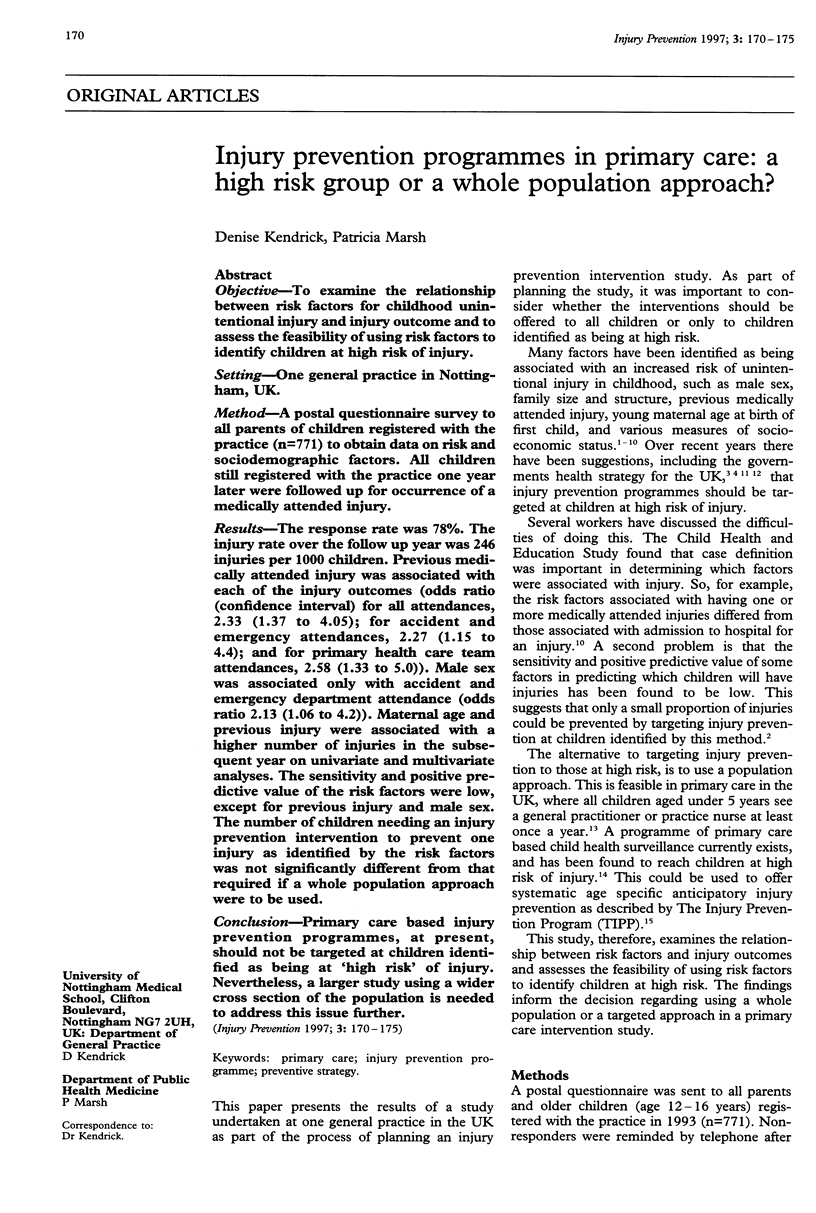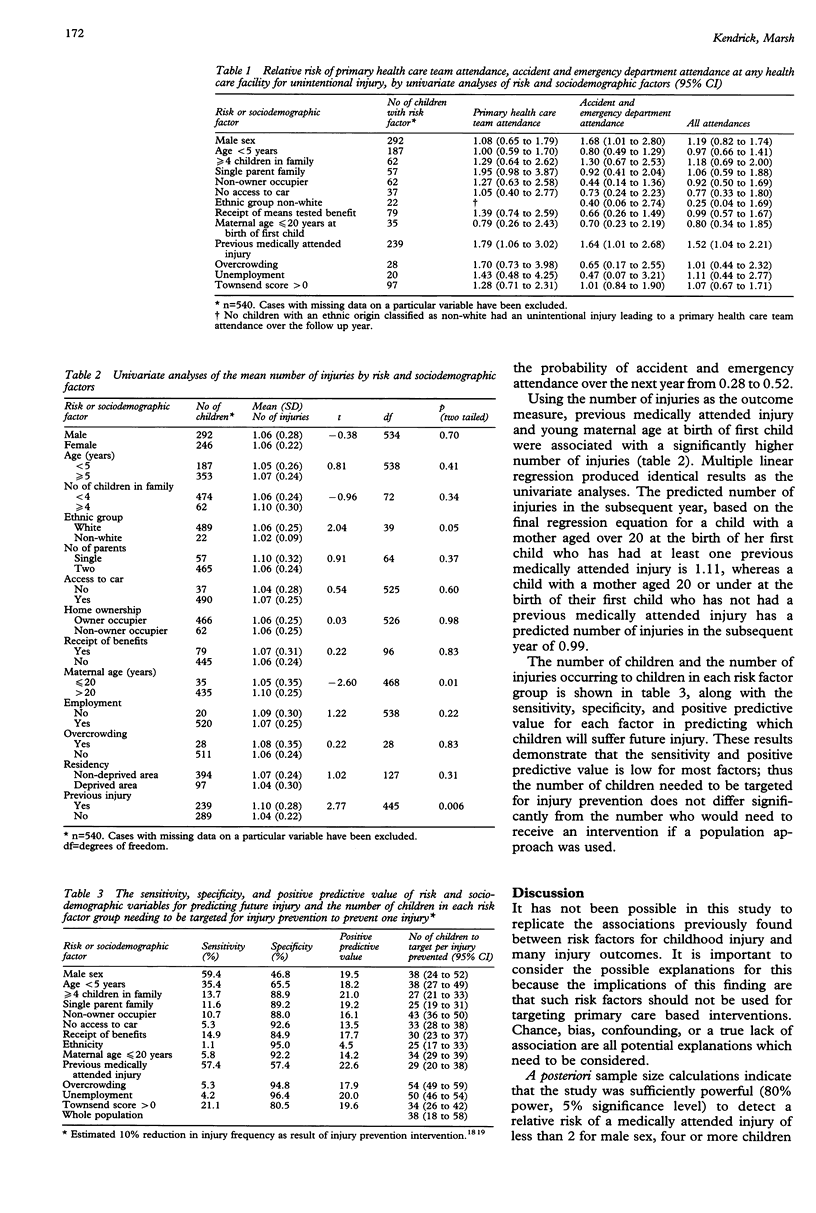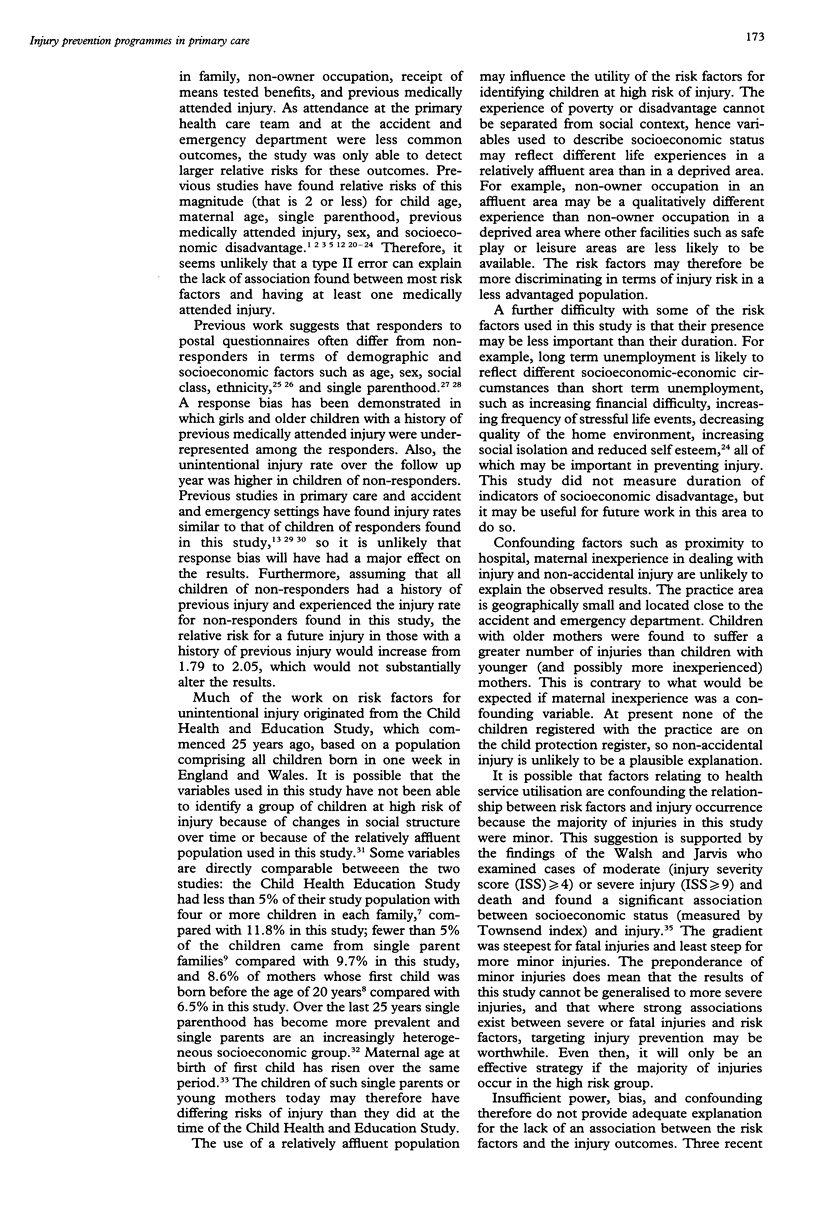Abstract
OBJECTIVE: To examine the relationship between risk factors for childhood unintentional injury and injury outcome and to assess the feasibility of using risk factors to identify children at high risk of injury. SETTING: One general practice in Nottingham, UK. METHOD: A postal questionnaire survey to all parents of children registered with the practice (n = 771) to obtain data on risk and sociodemographic factors. All children still registered with the practice one year later were followed up for occurrence of a medically attended injury. RESULTS: The response rate was 78%. The injury rate over the follow up year was 246 injuries per 1000 children. Previous medically attended injury was associated with each of the injury outcomes (odds ratio (confidence interval) for all attendances, 2.33 (1.37 to 4.05); for accident and emergency attendances, 2.27 (1.15 to 4.4); and for primary health care team attendances, 2.58 (1.33 to 5.0)). Male sex was associated only with accident and emergency department attendance (odds ratio 2.13 (1.06 to 4.2)). Maternal age and previous injury were associated with a higher number of injuries in the subsequent year on univariate and multivariate analyses. The sensitivity and positive predictive value of the risk factors were low, except for previous injury and male sex. The number of children needing an injury prevention intervention to prevent one injury as identified by the risk factors was not significantly different from that required if a whole population approach were to be used. CONCLUSION: Primary care based injury prevention programmes, at present, should not be targeted at children identified as being at 'high risk' of injury. Nevertheless, a larger study using a wider cross section of the population is needed to address this issue further.
Full text
PDF





Selected References
These references are in PubMed. This may not be the complete list of references from this article.
- Agass M., Mant D., Fuller A., Coulter A., Jones L. Childhood accidents: a practice survey using general practitioners' records and parental reports. Br J Gen Pract. 1990 May;40(334):202–205. [PMC free article] [PubMed] [Google Scholar]
- Bartley M. Unemployment and ill health: understanding the relationship. J Epidemiol Community Health. 1994 Aug;48(4):333–337. doi: 10.1136/jech.48.4.333. [DOI] [PMC free article] [PubMed] [Google Scholar]
- Bass J. L., Mehta K. A., Ostrovsky M. Childhood injury prevention in a suburban Massachusetts population. Public Health Rep. 1991 Jul-Aug;106(4):437–442. [PMC free article] [PubMed] [Google Scholar]
- Bijur P. E., Golding J., Haslum M. Persistence of occurrence of injury: can injuries of preschool children predict injuries of school-aged children? Pediatrics. 1988 Nov;82(5):707–712. [PubMed] [Google Scholar]
- Bijur P. E., Golding J., Kurzon M. Childhood accidents, family size and birth order. Soc Sci Med. 1988;26(8):839–843. doi: 10.1016/0277-9536(88)90176-1. [DOI] [PubMed] [Google Scholar]
- Bijur P., Golding J., Haslum M., Kurzon M. Behavioral predictors of injury in school-age children. Am J Dis Child. 1988 Dec;142(12):1307–1312. doi: 10.1001/archpedi.1988.02150120061041. [DOI] [PubMed] [Google Scholar]
- Boyce W. T., Sobolewski S. Recurrent injuries in schoolchildren. Am J Dis Child. 1989 Mar;143(3):338–342. doi: 10.1001/archpedi.1989.02150150096024. [DOI] [PubMed] [Google Scholar]
- Eminson C. J., Jones H., Goldacre M. Repetition of accidents in young children. J Epidemiol Community Health. 1986 Jun;40(2):170–173. doi: 10.1136/jech.40.2.170. [DOI] [PMC free article] [PubMed] [Google Scholar]
- Kendrick D. Accidental injury attendances as predictors of future admission. J Public Health Med. 1993 Jun;15(2):171–174. [PubMed] [Google Scholar]
- Kendrick D., West J., Wright S., Presbury M. Does routine child health surveillance reach children most at risk of accidental injury? J Public Health Med. 1995 Mar;17(1):39–45. [PubMed] [Google Scholar]
- Kravitz H. Prevention of accidental falls in infancy by counseling mothers. IMJ Ill Med J. 1973 Dec;144(6):570–573. [PubMed] [Google Scholar]
- Lyons R. A., Lo S. V., Heaven M., Littlepage B. N. Injury surveillance in children--usefulness of a centralised database of accident and emergency attendances. Inj Prev. 1995 Sep;1(3):173–176. doi: 10.1136/ip.1.3.173. [DOI] [PMC free article] [PubMed] [Google Scholar]
- Manheimer D. I., Dewey J., Mellinger G. D., Corsa L., Jr 50,000 child-years of accidental injuries. Public Health Rep. 1966 Jun;81(6):519–533. [PMC free article] [PubMed] [Google Scholar]
- McKee C. M., Gleadhill D. N., Watson J. D. Accident and emergency attendance rates: variation among patients from different general practices. Br J Gen Pract. 1990 Apr;40(333):150–153. [PMC free article] [PubMed] [Google Scholar]
- Reilly T. G., Walt R. P. Duodenal ulcer treatment: progress from pH to HP. J Clin Pharm Ther. 1994 Apr;19(2):73–80. doi: 10.1111/j.1365-2710.1994.tb01115.x. [DOI] [PubMed] [Google Scholar]
- Roberts I. Sole parenthood and the risk of child pedestrian injury. J Paediatr Child Health. 1994 Dec;30(6):530–532. doi: 10.1111/j.1440-1754.1994.tb00727.x. [DOI] [PubMed] [Google Scholar]
- Sellar C., Ferguson J. A., Goldacre M. J. Occurrence and repetition of hospital admissions for accidents in preschool children. BMJ. 1991 Jan 5;302(6767):16–19. doi: 10.1136/bmj.302.6767.16. [DOI] [PMC free article] [PubMed] [Google Scholar]
- Stewart-Brown S., Peters T. J., Golding J., Bijur P. Case definition in childhood accident studies: a vital factor in determining results. Int J Epidemiol. 1986 Sep;15(3):352–359. doi: 10.1093/ije/15.3.352. [DOI] [PubMed] [Google Scholar]
- Taylor B., Wadsworth J., Butler N. R. Teenage mothering, admission to hospital, and accidents during the first 5 years. Arch Dis Child. 1983 Jan;58(1):6–11. doi: 10.1136/adc.58.1.6. [DOI] [PMC free article] [PubMed] [Google Scholar]
- Wadsworth J., Burnell I., Taylor B., Butler N. Family type and accidents in preschool children. J Epidemiol Community Health. 1983 Jun;37(2):100–104. doi: 10.1136/jech.37.2.100. [DOI] [PMC free article] [PubMed] [Google Scholar]
- Walsh S. S., Jarvis S. N. Measuring the frequency of "severe" accidental injury in childhood. J Epidemiol Community Health. 1992 Feb;46(1):26–32. doi: 10.1136/jech.46.1.26. [DOI] [PMC free article] [PubMed] [Google Scholar]


